Matsumoto Castle - Pride of the City: Part 2
By Deborah Klens-Bigman, Ph.D
Editor’s Note: This is the second of a two part
article on Matsumoto Castle. See Part
1. Readers might also be interested
in Klens-Bigman’s
article on another famous Japanese historic Samurai castle Shirasagi
located near Osaka in Himijijo. See: ”A
visit to the "Samurai
Castle" – Himejijo.”
Some literature provided by the city notes that Matsumoto Jo was constructed
with the idea of both fighting with and defending itself from teppo,
Japanese firearms. The inner moat, for example, was designed to be 60
meters wide to put it out of reach of most arms fire. The brochure also
notes that the castle made use of long barrel "Hazama guns" which
had a range of more than 300 meters. The second floor of the Main Tower
of castle boasts a formidable collection of teppo, donated to the city
by Matsumoto native Akahane Michishige and his wife in 1991. The exhibit
features many kinds of firing weapons, including a 250-gram loader that
may have been importantly involved in the Battle for Osaka Castle in
1607. Illustrations show different means of transporting and firing various
weapons. Given Matsumoto Jo's facility in using and defending against
teppo, the castle is a fitting exhibition space.
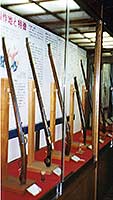 |
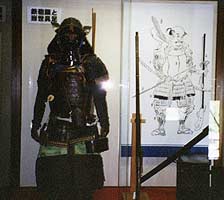 |
(Right) Teppo on display on the second floor of the
Main Tower. (Left) A suit of armor, along with an illustration of a
teppo-toting marksman. |
 |
An illustration shows the method for firing teppo from horseback
and from a boat. |
 |
A means of melting lead and molding bullets. |
The third floor is the hidden floor, also called the "dark floor",
as it has no windows and is not visible to the outside. It was also used
for storage, but may have had some kind of strategic value as well. Every
castle had hidden floors (and sometimes hidden passages - Shirasagi Jo
has both). In the heat of battle the hidden floor may have provided advantage
to the defenders. While the enemy would have been aware of the existence
of a hidden floor, its location may not have been obvious until the invaders
were trapped inside, in the dark.
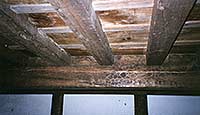 The
fourth floor presents a real contrast to the one below. The beams have
been finished and the pillars that run throughout the building
are less evident here. More windows give more light and the floor,
though it is smaller than the ones below, seems larger and more spacious.
It is possible this was the lord's chamber, where he conducted the
business of the castle and the surrounding area. He would not have
slept here; a comfortable house on the castle grounds (now gone) would
have served as an official residence. The commentary on this floor
speculates that folding screens and curtains may have marked off certain
areas, rather than
actual walls. The result was probably better circulation of air
and light, especially in hot weather, as well as maintaining a sense
of grandeur appropriate to a castle lord's position. The
fourth floor presents a real contrast to the one below. The beams have
been finished and the pillars that run throughout the building
are less evident here. More windows give more light and the floor,
though it is smaller than the ones below, seems larger and more spacious.
It is possible this was the lord's chamber, where he conducted the
business of the castle and the surrounding area. He would not have
slept here; a comfortable house on the castle grounds (now gone) would
have served as an official residence. The commentary on this floor
speculates that folding screens and curtains may have marked off certain
areas, rather than
actual walls. The result was probably better circulation of air
and light, especially in hot weather, as well as maintaining a sense
of grandeur appropriate to a castle lord's position.
 |
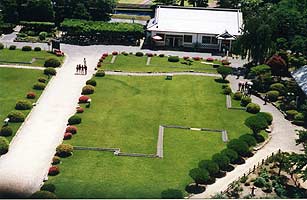 |
(Left) Summer-woven curtains provide privacy and allow
air circulation on the fourth floor (the loudspeaker is not part
of the original door). (Right) foundation of the daimyo's residence
is outlined in stone in the garden below. |
The fifth floor has good visibility on all sides. This was the strategic
office, and I could see the outer perimeters very well in every direction.
Down below, inside the castle complex is a garden where outlines of buildings
that collapsed long ago, including the daimyo's residence, are picked
out in stone, accented by brilliant azaleas.
The formidably steep climb eventually brought me to the very top, to
a very small room indeed, from which we could see the city in all directions,
and the mountains beyond.
From the top floor, we were directed down to the Southern Wing, to yet
another unique feature of Matsumoto Jo.
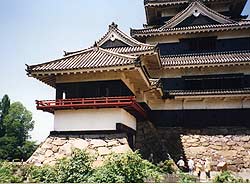 |
The Moon-Viewing Tower. |
Lord Naomasa Matsudaira, a grandson of Tokugawa, Ieyasu (Japanese military
leader and statesman, founder of the Tokugawa dynasty of Shoguns who
ended the chaotic period of feuding clans by unifying Japan under a single
military rule), convinced, eventually, that peace was here to stay, had
a vermillion-trimmed Moon-Viewing Tower constructed in the 1630's. It
is the only bit of color to be seen in the castle complex. The room was
very pleasantly situated, with windows on three sides to let in the view
and any passing breeze. I could imagine there had been many pleasant
evenings here.
Matsumoto Jo remained in the hands of Tokugawa daimyo until the change
of government in 1868. At that point, the Toda family, who had been the
area's last shogunal administrators, left the castle and the buildings
became the property of the Imperial government. Matsumoto Jo was to be
auctioned off, in pieces if necessary, apparently the fate of many Tokugawa
official buildings. The proud citizens of Matsumoto, however, took matters
into their own hands. A plaque in the garden below notes that a gentleman
named Ichikawa Ryozo led the movement to raise money and buy the buildings
and grounds intact. In some ways Matsumoto Jo and the Tokugawa administration
had made Matsumoto the proud city it had become, and apparently the citizenry
decided to repay the favor.
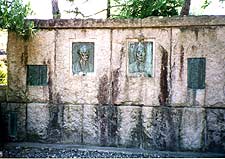 |
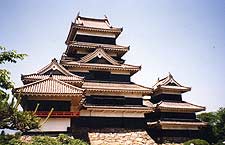 |
(Left) A plaque in the garden honors the
two "Men
of Merit" who
saved Matsumoto Jo: Ichikawa (left) and Kobayashi (right). (Right)Pride
of the City - A view of Matsumoto Jo from the inner garden. |
By the early 20th century, however, the castle had fallen into disrepair,
and the elements were in danger of accomplishing what the Meiji government
did not do. This time it was Kobayashi Unari, a headmaster of the Matsumoto
Middle School, who led the movement to raise money for restoration and
creation of the surrounding park, in 1902. Now, as a National Treasure
of Japan, Matsumoto Jo stands proud in the center of town, where its
citizens come to cool themselves by the inner moat, and admire it for
many hot spring and summer days to come.
About The Author:
Deborah Klens-Bigman is Manager and Associate Instructor of iaido at
New York Budokai in New York City. She has also studied, to varying extents,
kendo, jodo (short staff), kyudo (archery) and naginata (halberd). She
received her Ph.D in 1995 from New York University's Department of Performance
Studies where she wrote her dissertation on Japanese classical dance
(Nihon Buyo). and she continues to study Nihon Buyo with Fujima Nishiki
at the Ichifuji-kai Dance Association. Her article on the application
of performance theory to Japanese martial arts appeared in the Journal
of Asian Martial Arts in the summer of 1999. She is married to artist
Vernon Bigman. For FightingArts.com she is Associate Editor for Japanese
Culture/Sword Arts.
|